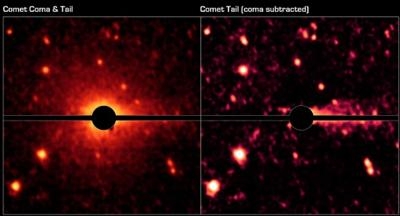Thu, Sep 19, 2013
Spitzer Telescope Detected 'Comet Activity' From Don Quixote
For 30 years, a large near-Earth asteroid wandered its lone, intrepid path, passing before the scrutinizing eyes of scientists armed with telescopes while keeping something to itself. The object, known as Don Quixote, whose journey stretches to the orbit of Jupiter, now appears to be a comet. The discovery resulted from an ongoing project coordinated by researchers at Northern Arizona University, Flagstaff, AZ, using NASA's Spitzer Space Telescope. Through a lot of focused attention and a little luck, they found evidence of comet activity, which had evaded detection for three decades.

The results show that Don Quixote is not, in fact, a dead comet, as previously believed, but it has a faint coma and tail. In fact, this object, the third-biggest near-Earth asteroid known, skirts Earth with an erratic, extended orbit and is “sopping wet,” said David Trilling of Northern Arizona University, with large deposits of carbon dioxide and presumably water ice. Don Quixote is about 11 miles long. “This discovery of carbon dioxide emission from Don Quixote required the sensitivity and infrared wavelengths of the Spitzer telescope and would not have been possible using telescopes on the ground,” said Michael Mommert, who conducted the research at the German Aerospace Center, Berlin, before moving to Northern Arizona University. This discovery implies that carbon dioxide and water ice might be present on other near-Earth asteroids, as well.
The implications have less to do with a potential impact, which is extremely unlikely in this case, and more with “the origins of water on Earth,” Trilling said. Impacts with comets like Don Quixote over geological time may be the source of at least some of it, and the amount on Don Quixote represents about 100 billion tons of water -- roughly the same amount that can be found in Lake Tahoe, CA.
Mommert presented the results at the European Planetary Science Congress in London on Sept. 10.
(Image provided by NASA)
More News
“This incremental order marks another milestone in our company’s growth strategy. The Boeing 737 MAX offers exceptional fuel efficiency, reliability, and passenger comf>[...]
From 2015 (YouTube Edition): One Of The Most Revered Classic SportPlanes Gets A New Set Of Wings... And Capabilities If you try to think about a kit airplane company that has passe>[...]
Aero Linx: Society of Air Racing Historians The Society of Air Racing Historians (SOARH) is dedicated to preserving the complete and accurate records of air races, race pilots, and>[...]
The Entire Instrument Panel Lost Power, And Then The Engine Lost Power On August 6, 2025, about 1925 central daylight time, a Vans RV4 airplane, N595BS, was substantially damaged w>[...]
We're Everywhere... Thanks To You! Even with the vast resources and incredibly far-reaching scope of the Aero-News Network, every now and then a story that should be reported on sl>[...]
 Aero-News: Quote of the Day (09.03.25)
Aero-News: Quote of the Day (09.03.25) Classic Aero-TV: 'WHOA Control' To The Max: Kitfox S7 STi Gets MORE STOLworthy!
Classic Aero-TV: 'WHOA Control' To The Max: Kitfox S7 STi Gets MORE STOLworthy! ANN's Daily Aero-Linx (09.03.25)
ANN's Daily Aero-Linx (09.03.25) NTSB Prelim: Vans RV4
NTSB Prelim: Vans RV4 ANN FAQ: How Do I Become A News Spy?
ANN FAQ: How Do I Become A News Spy?



